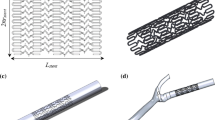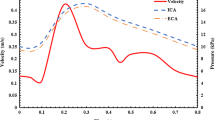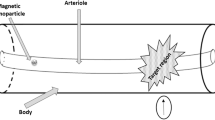Abstract
Purpose
In the present paper, the magnetic drug targeting using drug coated Fe3O4 nanoparticles to the stenosis region of the vessel was investigated. The problem was solved for various magnetic numbers. Moreover, the effect of the location of the wire, as a magnetic source, on the MDT was studied.
Methods
The governing equations of continuity, momentum and volume fraction were solved by taking into account the effects of kelvin force and magnetophoresis. Finite volume method is used for discretization of unsteady two-phase flow equations.
Results
In low magnetic numbers, the most important phenomenon is the gradual formation of drug droplet on the location of the wire. The drug drop holds the drug near the target tissue for a long time and has a positive role in the MDT as a source of drug over time. Also, in high magnetic numbers, the amount of drug in the tissue is also high at the time of the formation of the droplet. However, the number of vortices formed in the flow increases, and this leads to get the target further away from the tissue. Two main phenomena of drug droplet formation and vortices generation were observed as positive and negative factors in MDT, respectively. The results showed that in a specific magnetic number, the MDT function could be optimal. If the wire is located in the upstream region of the stenosis, it will have a small positive effect on the concentration of the drug in the target tissue.


















Similar content being viewed by others
References
Akbar, N. S. Metallic nanoparticles analysis for the blood flow in tapered stenosed arteries: application in nanomedicines. Int. J. Biomath. 9:1650002, 2016.
Aminfar, H., M. Mohammadpourfard, and S. A. Zonouzi. Numerical study of the ferrofluid flow and heat transfer through a rectangular duct in the presence of a non-uniform transverse magnetic field. J. Magn. Magn. Mater. 327:31–42, 2013.
Badfar, H., S. Y. Motlagh, and A. Sharifi. Study of blood flow inside the stenosis vessel under the effect of solenoid magnetic field using ferrohydrodynamics principles. Eur. Phys. J. Plus 132:440, 2017.
Calandrini, S., G. Capodaglio, and E. Aulisa. Magnetic drug targeting simulations in blood flows with fluid-structure interaction. Int. J. Numer. Methods Biomed. Eng. 34(4):e2954, 2017.
Cherry, E. M., and J. K. Eaton. A comprehensive model of magnetic particle motion during magnetic drug targeting. Int. J. Multiph. Flow 59:173–185, 2014.
Cho, K., X. Wang, S. Nie, and D. M. Shin. Therapeutic nanoparticles for drug delivery in cancer. Clin. Cancer Res. 14:1310–1316, 2008.
Ellahi, R., S. Rahman, M. M. Gulzar, S. Nadeem, and K. Vafai, A mathematical study of non-Newtonian micropolar fluid in arterial blood flow through composite stenosis. Appl. Math. Inf. Sci. 8:1567, 2014.
Felicia, L.J., and J. Philip. Effect of hydrophilic silica nanoparticles on the magnetorheological properties of ferrofluids: a study using opto-magnetorheometer. Langmuir 31:3343–3353, 2015.
Finol, E. A., and C. H. Amon. Blood flow in abdominal aortic aneurysms: pulsatile flow hemodynamics. J. Biomech. Eng. 123:474–484, 2001.
Ganguly, R., A. P. Gaind, S. Sen, and I. K. Puri. Analyzing ferrofluid transport for magnetic drug targeting. J. Magn. Magn. Mater. 289:331–334, 2005.
Haik, Y., V. Pai, and C. Chen. Biomagnetic fluid dynamics. In: Fluid Dynamics at Interfaces. Cambridge: Cambridge University Press, pp. 439–452, 1999.
Ho, C., W. Liu, Y. Chang, and C. Lin, Natural convection heat transfer of alumina-water nanofluid in vertical square enclosures: an experimental study. Int. J. Therm. Sci. 49:1345–1353, 2010.
Kayal, S., D. Bandyopadhyay, T. K. Mandal, and R. V. Ramanujan. The flow of magnetic nanoparticles in magnetic drug targeting. RSC Adv. 1:238–246, 2011.
Khashan, S. A., and Y. Haik. Numerical simulation of biomagnetic fluid downstream an eccentric stenotic orifice. Phys. Fluids 18:113601, 2006.
Kittel, C., P. McEuen, and P. McEuen. Introduction to Solid State Physics, vol. 8. New York: Wiley, 1996.
Lübbe, A. S., C. Bergemann, H. Riess, F. Schriever, P. Reichardt, K. Possinger, M. Matthias, B. Dörken, F. Herrmann, R. Gürtler, et al., Clinical experiences with magnetic drug targeting: a phase i study with 4-epidoxorubicin in 14 patients with advanced solid tumors. Cancer Res. 56:4686–4693, 1996.
Motlagh, S. Y., and H. Soltanipour, Natural convection of Al2O3-water nanofluid in an inclined cavity using Buongiorno’s two-phase model. Int. J. Therm. Sci. 111:310–320, 2017.
Motlagh, S. Y., S. Taghizadeh, and H. Soltanipour, Natural convection heat transfer in an inclined square enclosure filled with a porous medium saturated by nanofluid using Buongiorno’s mathematical model. Adv. Powder Technol. 27:2526–2540, 2016.
Nadeem, S., and S. Ijaz, Theoretical examination of nanoparticles as a drug carrier with slip effects on the wall of stenosed arteries. Int. J. Heat Mass Transf. 93:1137–1149, 2016.
Nadeem, S., S. Ijaz, and M. Adil Sadiq. Inspiration of induced magnetic field on a blood flow of Prandtl nanofluid model with stenosis. Curr. Nanosci. 10:753–765, 2014.
Ody, T., M. Panth, A. Sommers, and K. Eid, Controlling the motion of ferrofluid droplets using surface tension gradients and magnetoviscous pinning. Langmuir 32:6967–6976, 2016.
Reszka, R., P. Beck, I. Fichtner, M. Hentschel, J. Richter, and J. Kreuter. Body distribution of free, liposomal and nanoparticle-associated mitoxantrone in B16-melanoma-bearing mice. J. Pharmacol. Exp. Ther. 280:232–237, 1997.
Rigoni, C., D. Ferraro, M. Carlassara, D. Filippi, S. Varagnolo, M. Pierno, D. Talbot, A. Abou-Hassan, and G. Mistura. Dynamics of ferrofluid drops on magnetically patterned surfaces. Langmuir 34(30):8917–8922, 2018.
Rigoni, C., M. Pierno, G. Mistura, D. Talbot, R. Massart, J.-C. Bacri, and A. Abou-Hassan. Static magnetowetting of ferrofluid drops. Langmuir 32:7639–7646, 2016.
Rosensweig, R. E. Ferrohydrodynamics. Cambridge: Cambridge University Press, 1985.
Sharifi, A., S. Y. Motlagh, and H. Badfar. Numerical investigation of magnetic drug targeting using magnetic nanoparticles to the aneurysmal vessel. J. Magn. Magn. Mater. 474:236–245, 2019.
Sharifi, A., S. Y. Motlagh, and H. Badfar. Ferro hydro dynamic analysis of heat transfer and biomagnetic fluid flow in channel under the effect of two inclined permanent magnets. J. Magn. Magn. Mater. 472:115–122, 2019.
Sheikhzadeh, G. A., M. Dastmalchi, and H. Khorasanizadeh. Effects of nanoparticles transport mechanisms on Al2O3-water nanofluid natural convection in a square enclosure. Int. J. Therm. Sci. 66:51–62, 2013.
Shliomis, M. I. Convective instability of magnetized ferrofluids: influence of magnetophoresis and soret effect. In: Thermal Nonequilibrium Phenomena in Fluid Mixtures, edited by M.I. Shliomis. Berlin: Springer, pp. 355–371, 2002.
Srivastav, R. K. Mathematical model of blood flow through a composite stenosis in catheterized artery with permeable wall. Appl. Appl. Math. 9(1):58–74, 2014.
Sun, C., J. S. Lee, and M. Zhang. Magnetic nanoparticles in MR imaging and drug delivery. Adv. Drug Deliv. Rev. 60:1252–1265, 2008.
Sun, J., Y. Li, X. J. Liang, and P. C. Wang, Bacterial magnetosome: a novel biogenetic magnetic targeted drug carrier with potential multifunctions. J. Nanomater. 2011:469031–469043, 2011.
Tzirtzilakis, E. E. A mathematical model for blood flow in magnetic field. Phys. Fluids 17:077103, 2005.
Tzirtzilakis, E. Biomagnetic fluid flow in an aneurysm using ferrohydrodynamics principles. Phys. Fluids 27:061902, 2015.
Tzirtzilakis, E., and N. Kafoussias. Three-dimensional magnetic fluid boundary layer flow over a linearly stretching sheet. J. Heat Transf. 132:011702, 2010.
Veiseh, O., J. W. Gunn, and M. Zhang. Design and fabrication of magnetic nanoparticles for targeted drug delivery and imaging. Adv. Drug Deliv. Rev. 62:284–304, 2010.
Yamaguchi, H. Engineering Fluid Mechanics, vol. 85. Berlin: Springer, 2008.
Yin, R.-X., D.-Z. Yang, and J.-Z. Wu. Nanoparticle drug- and gene-eluting stents for the prevention and treatment of coronary restenosis. Theranostics 4:175, 2014.
Yu, S., and G.-M. Chow. Preparation of Polymer-Coated Functionalized Ferrimagnetic Iron Oxide Nanoparticles, Massachusetts Institute of Technology, Cambridge, 2004.
Zhu, G.-P., N.-T. Nguyen, R. V. Ramanujan, and X.-Y. Huang. Nonlinear deformation of a ferrofluid droplet in a uniform magnetic field. Langmuir 27:14834–14841, 2011.
Author information
Authors and Affiliations
Corresponding author
Additional information
Associate Editor Frank Gijsen oversaw the review of this article.
Publisher's Note
Springer Nature remains neutral with regard to jurisdictional claims in published maps and institutional affiliations.
Rights and permissions
About this article
Cite this article
Badfar, H., Yekani Motlagh, S. & Sharifi, A. Numerical Simulation of Magnetic Drug Targeting to the Stenosis Vessel Using Fe3O4 Magnetic Nanoparticles Under the Effect of Magnetic Field of Wire. Cardiovasc Eng Tech 11, 162–175 (2020). https://doi.org/10.1007/s13239-019-00446-x
Received:
Accepted:
Published:
Issue Date:
DOI: https://doi.org/10.1007/s13239-019-00446-x




